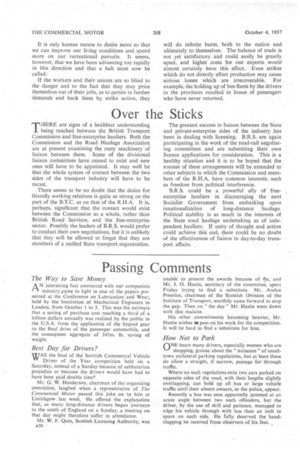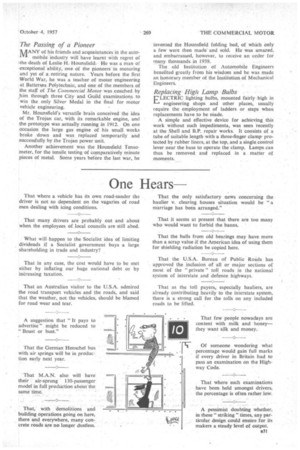Passing Comments
Page 36

Page 37

If you've noticed an error in this article please click here to report it so we can fix it.
The Way to Save Money
A N interesting fact connected with our companion
industry.,,came to light in one of the papers presented at the Conference on Lubrication and Wear, held by the Institution of Mechanical Engineers in London, from October 1 to 3. This was the estimate that a saving of purchase cost reaching a third of a billion dollars annually was realized by the public in the U.S.A. from the application of the hypoid gear to the final drive of the passenger automobile, and the consequent aggregate of 345m. lb. saving of weight.
Best Day for Drivers?
WAS the final of the Scottish Commercial Vehicle
Driver of the Year competition held on a Saturday, instead of a Sunday because of sabbatarian prejudice or because the drivers would have had to have been paid double time? Mr. G. W. Henderson, chairman of the organizing committee, laughed when a representative of The Commercial Motor passed this joke on to him at Linlithgow last week. He offered the explanation that, as many long-distance drivers began journeys to the south of England on a Sunday, a meeting on that day might therefore suffer in attendance. Mr. W. F. Quin, Scottish Licensing Authority, was s30
unable to present the awards because of flu, and Mr. J. 0. Hastie, secretary of the committee, spent Friday trying to find a substitute. Mr. Archie Prentice, chairman of the Scottish Division of the Institute of Transport, worthily came forward to stop the gap. Then on "the day" Mr. Hastie went down with this malaise.
His other commitments becoming heavier, Mr. Hastie wishes to pass on his work for the competition. It will be hard to find a substitute for him.
How Not to Park
rINE hears many drivers, especially women who are
shopping, grouse about the " nuisance " of smalltown unilateral parking regulatiOns, but at least these do allow a straight, if narrow, passage for through traffic.
Where no such regulations exist two cars parked on opposite sides of the road, with their lengths slightly overlapping, can hold up all, bus or large vehicle traffic until their absent owners, or the police, appear.
Recently a bus was seen apparently jammed at an acute angle between two such offenders, but the driver, by the use of skill and patience, managed to edge his vehicle through with less than an inch to spare on each side. He fully deserved the handclapping he received from observers of his feat.
The Passing of a Pioneer
MANY of his friends and acquaintances in the auto
mobile industry will have learnt With regret of the death of Leslie H. Hounsfield. He was a man of exceptional 'ability, one of the pioneers in motoring and yet of a retiring nature. Years before the first World War, he was a teacher of motor engineering
• at Battersea Polytechnic, and one of the members of the staff of The Commercial Motor was coached by him through three City and Guild examinations to win the only Silver Medal in the final for motor vehicle engineering.
Mr. Hounsfield's versatile brain conceived the idea of the Trojan car, with its remarkable engine, and the prototype was actually running in 1912. On one occasion the large gas engine of his small works broke down and was replaced temporarily and successfully by the Trojan power unit.
Another achievement was the Hounsfield Tensometer, for the tensile testing of comparatively minute pieces of metal. Some years before the last war, he • invented the Hounsfield folding bed, of which only a few were then made and sold. He was amazed, and embarrassed, however, to receive an order for many thousands. in 1939, The old institution of Automobile Engineers benefited greatly from his wisdom and he was made an honorary member of the Institution of Mechanical Engineers.
Replacing High Lamp Bulbs
ELECTRIC lighting bulbs, mounted fairly high in engineering shops and other places, usually require the employment of ladders or steps when replacements have to be made.
A simple and effective device for achieving this work without such impedimenta, was seen recently at the Shell and BR repair works. It consists of a tube of suitable length with a three-finger clamp, protected by rubber liners, at the top, and a single control lever near the base to operate the clamp. Lamps can thus be removed and replaced in a matter of moments.




















































































































